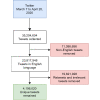Twitter Discussions and Emotions About the COVID-19 Pandemic: Machine Learning Approach
- PMID: 33119535
- PMCID: PMC7690968
- DOI: 10.2196/20550
Twitter Discussions and Emotions About the COVID-19 Pandemic: Machine Learning Approach
Abstract
Background: It is important to measure the public response to the COVID-19 pandemic. Twitter is an important data source for infodemiology studies involving public response monitoring.
Objective: The objective of this study is to examine COVID-19-related discussions, concerns, and sentiments using tweets posted by Twitter users.
Methods: We analyzed 4 million Twitter messages related to the COVID-19 pandemic using a list of 20 hashtags (eg, "coronavirus," "COVID-19," "quarantine") from March 7 to April 21, 2020. We used a machine learning approach, Latent Dirichlet Allocation (LDA), to identify popular unigrams and bigrams, salient topics and themes, and sentiments in the collected tweets.
Results: Popular unigrams included "virus," "lockdown," and "quarantine." Popular bigrams included "COVID-19," "stay home," "corona virus," "social distancing," and "new cases." We identified 13 discussion topics and categorized them into 5 different themes: (1) public health measures to slow the spread of COVID-19, (2) social stigma associated with COVID-19, (3) COVID-19 news, cases, and deaths, (4) COVID-19 in the United States, and (5) COVID-19 in the rest of the world. Across all identified topics, the dominant sentiments for the spread of COVID-19 were anticipation that measures can be taken, followed by mixed feelings of trust, anger, and fear related to different topics. The public tweets revealed a significant feeling of fear when people discussed new COVID-19 cases and deaths compared to other topics.
Conclusions: This study showed that Twitter data and machine learning approaches can be leveraged for an infodemiology study, enabling research into evolving public discussions and sentiments during the COVID-19 pandemic. As the situation rapidly evolves, several topics are consistently dominant on Twitter, such as confirmed cases and death rates, preventive measures, health authorities and government policies, COVID-19 stigma, and negative psychological reactions (eg, fear). Real-time monitoring and assessment of Twitter discussions and concerns could provide useful data for public health emergency responses and planning. Pandemic-related fear, stigma, and mental health concerns are already evident and may continue to influence public trust when a second wave of COVID-19 occurs or there is a new surge of the current pandemic.
Keywords: COVID-19; Twitter; Twitter data; infodemic; infodemiology; infoveillance; machine learning; public discussion; public sentiment; social media; virus.
©Jia Xue, Junxiang Chen, Ran Hu, Chen Chen, Chengda Zheng, Yue Su, Tingshao Zhu. Originally published in the Journal of Medical Internet Research (http://www.jmir.org), 25.11.2020.
Conflict of interest statement
Conflicts of Interest: None declared.
Figures
Similar articles
-
Topics, Trends, and Sentiments of Tweets About the COVID-19 Pandemic: Temporal Infoveillance Study.J Med Internet Res. 2020 Oct 23;22(10):e22624. doi: 10.2196/22624. J Med Internet Res. 2020. PMID: 33006937 Free PMC article.
-
Top Concerns of Tweeters During the COVID-19 Pandemic: Infoveillance Study.J Med Internet Res. 2020 Apr 21;22(4):e19016. doi: 10.2196/19016. J Med Internet Res. 2020. PMID: 32287039 Free PMC article.
-
Tweet Topics and Sentiments Relating to COVID-19 Vaccination Among Australian Twitter Users: Machine Learning Analysis.J Med Internet Res. 2021 May 19;23(5):e26953. doi: 10.2196/26953. J Med Internet Res. 2021. PMID: 33886492 Free PMC article.
-
Using Twitter-Based Data for Sexual Violence Research: Scoping Review.J Med Internet Res. 2023 May 15;25:e46084. doi: 10.2196/46084. J Med Internet Res. 2023. PMID: 37184899 Free PMC article.
-
Methods for Social Media Monitoring Related to Vaccination: Systematic Scoping Review.JMIR Public Health Surveill. 2021 Feb 8;7(2):e17149. doi: 10.2196/17149. JMIR Public Health Surveill. 2021. PMID: 33555267 Free PMC article.
Cited by
-
Willingness of the Jordanian Population to Receive a COVID-19 Booster Dose: A Cross-Sectional Study.Vaccines (Basel). 2022 Mar 9;10(3):410. doi: 10.3390/vaccines10030410. Vaccines (Basel). 2022. PMID: 35335042 Free PMC article.
-
Optimism and pessimism analysis using deep learning on COVID-19 related twitter conversations.Inf Process Manag. 2022 May;59(3):102918. doi: 10.1016/j.ipm.2022.102918. Epub 2022 Feb 25. Inf Process Manag. 2022. PMID: 36569234 Free PMC article.
-
Nurses' Work Concerns and Disenchantment During the COVID-19 Pandemic: Machine Learning Analysis of Web-Based Discussions.JMIR Nurs. 2023 Feb 6;6:e40676. doi: 10.2196/40676. JMIR Nurs. 2023. PMID: 36608261 Free PMC article.
-
COVID-19 Vaccine and Social Media in the U.S.: Exploring Emotions and Discussions on Twitter.Vaccines (Basel). 2021 Sep 23;9(10):1059. doi: 10.3390/vaccines9101059. Vaccines (Basel). 2021. PMID: 34696167 Free PMC article.
-
Sentiment analysis of epidemiological surveillance reports on COVID-19 in Greece using machine learning models.Front Public Health. 2023 Jul 18;11:1191730. doi: 10.3389/fpubh.2023.1191730. eCollection 2023. Front Public Health. 2023. PMID: 37533519 Free PMC article. Review.
References
-
- Center for Systems Science and Engineering (CSSE) COVID-19 Dashboard by CSSE at Johns Hopkins University (JHU) [2020-06-16]. https://www.arcgis.com/apps/opsdashboard/index.html#/bda7594740fd4029942....
-
- Rosenberg H, Syed S, Rezaie S. The Twitter pandemic: The critical role of Twitter in the dissemination of medical information and misinformation during the COVID-19 pandemic. CJEM. 2020 Jul;22(4):418–421. doi: 10.1017/cem.2020.361. http://europepmc.org/abstract/MED/32248871 - DOI - PMC - PubMed
-
- Scanfeld D, Scanfeld V, Larson EL. Dissemination of health information through social networks: twitter and antibiotics. Am J Infect Control. 2010 Apr;38(3):182–8. doi: 10.1016/j.ajic.2009.11.004. http://europepmc.org/abstract/MED/20347636 - DOI - PMC - PubMed
-
- Cheong M, Lee VCS. A microblogging-based approach to terrorism informatics: Exploration and chronicling civilian sentiment and response to terrorism events via Twitter. Inf Syst Front. 2010 Sep 29;13(1):45–59. doi: 10.1007/s10796-010-9273-x. - DOI
MeSH terms
LinkOut - more resources
Full Text Sources
Medical
Research Materials
Miscellaneous







